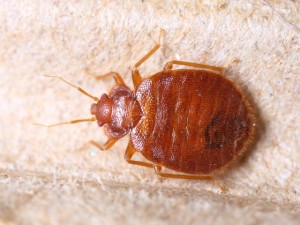 Bed bugs are small, wingless insects that feed on blood as their only source of nutrition. Due to their flattened body they can hide in small tight spaces such as cracks or gaps in bed frames, furniture, behind picture frames and other similar places, which makes it very difficult to detect them. Bad bugs do not cling to people but they are great at hitchhiking via personal belongings such as suitcases, bags and purses. An infestation can be confirmed by finding live bed bugs in a suspected area or room, concentrated or scattered dark spots such as bed bug fecal matter in nesting sites behind headboard, mattress seams etc; also sometimes by finding feeding blood marks or spots on the bed linen or pillow cases. Bites normally look like small, flat or raised areas that may become inflamed, itchy, red or blistered. People react differently to bed bug bites depending on the individual’s sensitivity. The reaction can be immediate or delayed.
Bed bugs are small, wingless insects that feed on blood as their only source of nutrition. Due to their flattened body they can hide in small tight spaces such as cracks or gaps in bed frames, furniture, behind picture frames and other similar places, which makes it very difficult to detect them. Bad bugs do not cling to people but they are great at hitchhiking via personal belongings such as suitcases, bags and purses. An infestation can be confirmed by finding live bed bugs in a suspected area or room, concentrated or scattered dark spots such as bed bug fecal matter in nesting sites behind headboard, mattress seams etc; also sometimes by finding feeding blood marks or spots on the bed linen or pillow cases. Bites normally look like small, flat or raised areas that may become inflamed, itchy, red or blistered. People react differently to bed bug bites depending on the individual’s sensitivity. The reaction can be immediate or delayed.
Prevention tips
- Having less clutter in a home reduces the chances of bed bug establishing themselves if introduced in the home, there is less harbourage for them. Therefore, clear up clutters.
- Inspect used furniture or clothes prior to buying or brining them into your home. Ask a seller if the items were checked for bed bugs.
- Use bed bug certified mattress, box spring and pillow encasements to prevent bed bugs from infesting and establishing in the mattresses and box spring. This will protect the mattress and box spring and hence preventing future disposal and replacement costs.
- When coming back home from a trip, keep your luggage in an isolated area such as the garage and immediately launder all cloth items. This helps keeping them out of your home.

